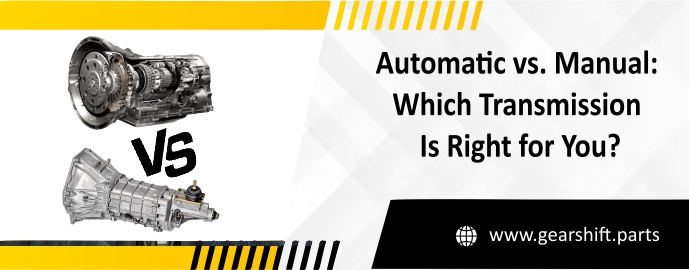
Automatic vs. Manual: Which Transmission Is Right for You?
Choice to choose between the automatic and manual transmission matters for car drivers. Automatic transmissions are in high-demand in the automotive industry. But that doesn’t mean manual transmissions are losing its existence. People who value driving control experience and lower ownership costs prefer manual transmission. Both the transmission has its own benefits and downsides. Choosing the right used transmission is important.
The automatic transmissions are designed for comfort but manual transmission focuses on control. Many drivers are switching to automatic transmission but still manual transmission is alive. Manual transmission cars for sale searches prove that there is demand of manual transmission among enthusiasts and budget-conscious drivers. Here in this guide, we will understand both the transmissions with their benefits and downsides and tips to maintain both the transmissions.
Understanding Automatic and Manual
- Automatic transmission automatically changes the gear using hydraulic systems, sensors, and advanced electronics technology. In this transmission, drivers don’t need to use a clutch pedal to change the gear.
- Manual Transmission is also called stick shift because it uses a clutch pedal and gear lever to change gears. In this transmission, driver changes the gear manually.
The difference is simple: automatic handles the work for you, manual puts you in charge.
Benefits of Manual Transmission
- Lower Cost: Manual vehicles usually cost less upfront. Automakers often add a premium to cars fitted with automatics. That makes manuals more attractive to budget buyers.
- Cheaper Maintenance: Manual gearboxes are mechanically simpler. Repairs and servicing usually cost less than automatic systems. For example, changing manual transmission fluid is generally less expensive than flushing or replacing automatic transmission fluid.
- Control: Drivers who want more involvement prefer manuals. A manual transmission lets you decide exactly when to shift. This control is especially useful on steep roads or in off-road conditions.
- Longevity: Manual gearboxes can last many years when maintained. As long as the clutch and fluid are serviced, manuals often outlast automatics.
- Enthusiast Appeal: Some drivers simply enjoy the process of shifting gears. It provides a mechanical connection that automatic systems don’t deliver.
Downsides of Manual Transmission
- Learning curve is harder, especially for new drivers.
- Traffic driving can be tiring with constant clutch use.
- Resale value is lower in markets where automatic dominates.
- Fewer manual transmission cars for sale compared to automatic models.
Benefits of Automatic Transmission
- Convenience: There is no clutch pedal and shifting. Automatic gearboxes are easy for anyone who wants to drive, even in stop-and-go city traffic.
- Availability: Most new vehicles today are automatic. That makes finding, buying, and reselling easier.
- Technology: Newer automatic transmissions are efficient, smooth, and deliver better fuel economy. Some of the advanced automatic transmissions come with driving modes and paddle shifters.
- Resale Value: Because most buyers prefer automatic, resale is generally higher compared to manual.
Downsides of Automatic Transmission
- Higher purchase cost compared to manual.
- More complex parts mean higher repair bills.
- Transmission fluid changes are usually more expensive.
- Less driving control compared to stick shift.
Maintenance Considerations
For manual cars:
- Check and replace manual transmission fluid at recommended intervals.
- Replace worn clutches to avoid shifting issues.
- Inspect shifter linkages and bushings.
For automatic cars:
- Change fluid and filter regularly to prevent overheating.
- Service according to manufacturer schedules.
- Watch for slipping gears or hesitation when shifting.
The good thing is that parts for both are widely available. At gearshift.parts, we continue to stock essentials for both automatic and manual drivers.
Choosing the Right Transmission
When deciding, drivers should look at:
- Driving Environment: City traffic favors automatic. Highways or rural areas make manual easier to live with.
- Budget: Manual saves money on purchase and upkeep. Automatic costs more but is convenient.
- Resale: Automatic holds value better in most markets.
- Personal Preference: If you enjoy driving and want more control, manual makes sense. If you want ease, automatic is the better fit.
Conclusion
In short, we can say that the demand of both the transmissions will continue as long as both exist. Manual transmissions are cheap, simple, and give more control but it requires effort and hard-to-find. Automatic transmissions are ruling the automotive market with their technology and comfort but it cost more to buy. There are still plenty of options for buyer looking for manual transmission cars for sale. Manual cars will last for years with proper care. Buying transmission depends on how much you value control, comfort, cost, and technology. Both the transmission serves the drivers in different ways which is why this debate is never ending.

